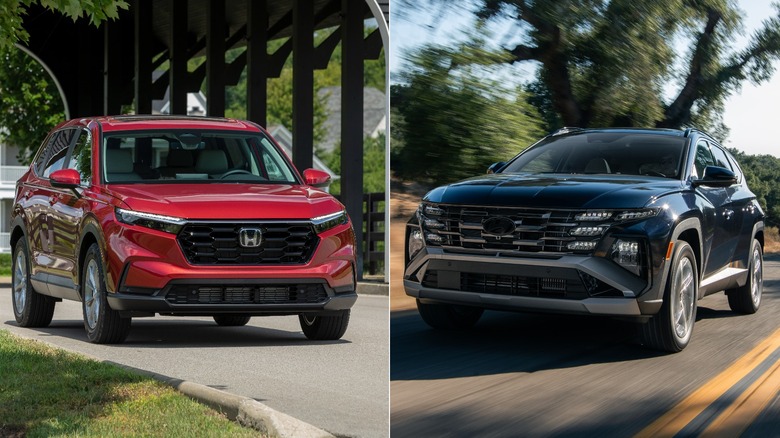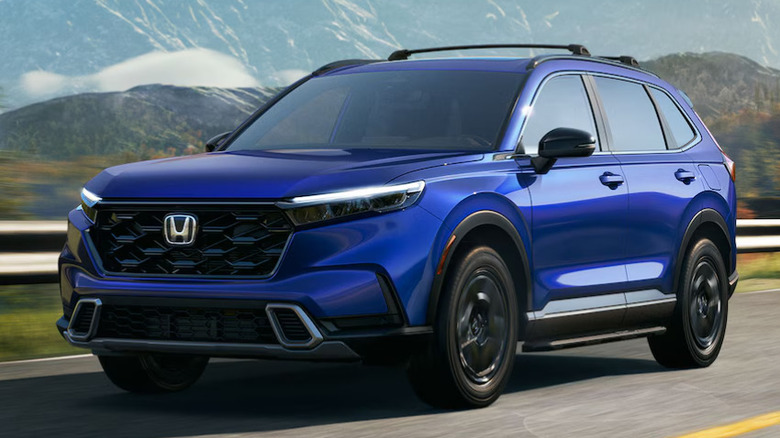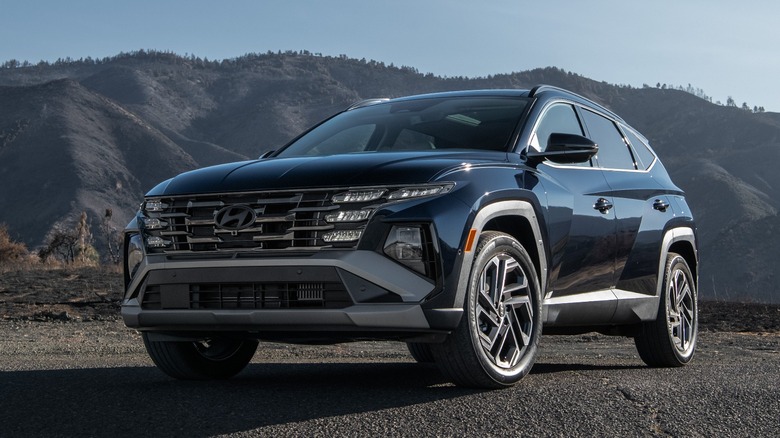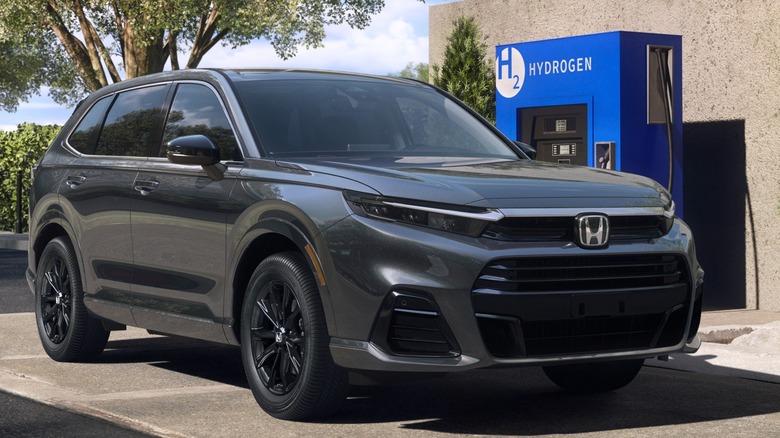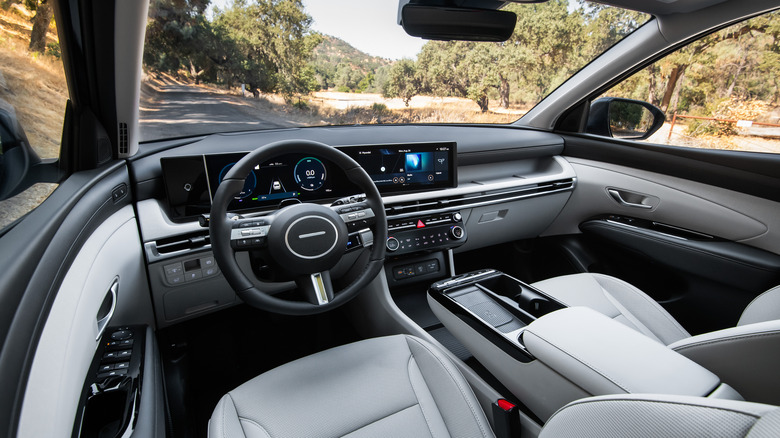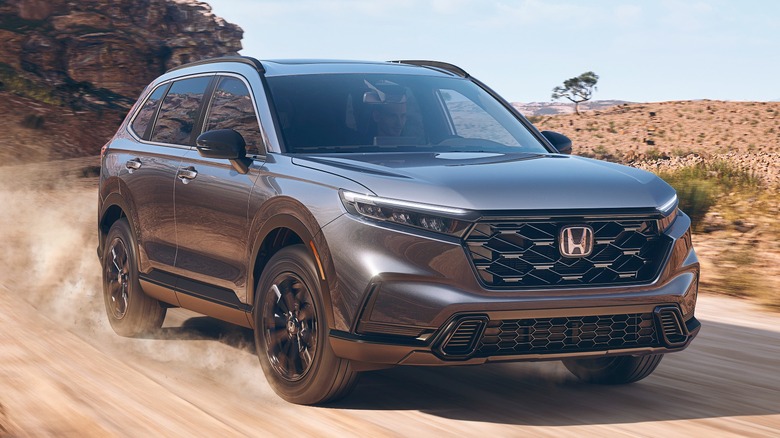2025 Honda CR-V Vs. Hyundai Tucson: How Do These New Compact SUVs Compare?
The Honda CR-V and Hyundai Tucson are some of the best-selling compact SUVs in America. The former is the more popular model, and has been around for much longer, with different generations of the CR-V sitting on the top three spots of Honda's 10 top-selling SUVs of all time. Nevertheless, there are other compact SUV alternatives to the CR-V available on the market, some of which even offer better features and performance.
One such competitor is the Hyundai Tucson. Although this compact SUV arrived nearly 10 years after the CR-V, the Tucson offers formidable competition to the Japanese automaker with its features and performance. Aside from that, Hyundai also has one of the best auto warranties on the market (5 years/60,000 miles for new vehicles, 10 years/100,000 miles for the powertrain), which is why some car owners and drivers choose the brand.
Because of this, it can get difficult to pick between the CR-V and Tucson if you're out shopping for a compact SUV. To help you out, we'll look at the details between the two models and then compare their biggest differences. That way, you'll be armed with some knowledge before you make your way to the dealer to check out these cars in the metal.
The Honda CR-V offers great space and a 'comfortable' driving experience
The 2025 Honda CR-V is the sixth iteration of Honda's compact SUV, introduced two years ago with the 2023 Honda CR-V. This model returns the CR-V to its boxy roots, while still retaining the comfort and spaciousness the CR-V's "Comfortable Roundabout Vehicle" namesake implies.
Aside from its new looks, it also gets a 7-inch (or 9-inch, depending on the variant) touchscreen with Android Auto and Apple CarPlay, and the Honda Sensing safety suite comes standard across all trims. It also comes with optional AWD for better traction control, but you do have to pay extra for that feature if you're getting the gasoline variant.
You can choose eight different colors for the CR-V: Urban Gray Pearl, Canyon River Blue Metallic, Crystal Black Pearl, Solar Silver Metallic, Meteorite Gray Metallic, Platinum White Pearl, Radiant Red Metallic, and Still Night Pearl. However, you might have to add $455 for some premium colors in this list. It's also available in either gasoline, hybrid, or hydrogen, delivering excellent fuel economy and allowing you to go green.
The facelifted Hyundai Tucson brings refined styling and high tech
The 2025 Hyundai Tucson is a facelift of the current fourth generation, which launched with the 2022 Hyundai Tucson model year. The biggest changes Hyundai made to the compact crossover SUV is a new front end and interior, plus more space and updated tech. Aside from that, the Tucson still retains the character of the pre-facelift car, especially with its futuristic design.
This compact SUV differentiates itself from the competition with its massive 12.3-inch touchscreen display, with wireless Android Auto and Apple CarPlay as standard. It also doesn't skimp on active safety features, as all variants come with Hyundai's SmartSense suite of safety tech. Hyundai also offers AWD as an option with this model for added safety and traction.
There are eight standard color options for the Tucson: Phantom Black, Rockwood Green, Atlantis Blue, Serenity White Pearl, Hampton Gray, Ultimate Red, Shimmering Silver, and Ecotronic Gray. You could also choose the Ecotronic Gray Matter if you go for the top-trim Limited variant. At the moment, you get the Tucson in either gasoline or hybrid, but Hyundai also plans to launch a plug-in hybrid version in the next few weeks.
Comparing powertrain options and fuel economy
Both compact SUVs offer three drivetrain options: The CR-V and Tucson are available in gasoline and hybrid, but Honda offers hydrogen fuel cell as the third-powertrain option, while Hyundai will soon offer a plug-in hybrid variant. Note that the CR-V's fuel-cell variant — called the Honda CR-V e:FCEV — is only available for lease in California, giving it a very limited release. On the other hand, the upcoming 2025 Hyundai Tucson PHEV is expected to be widely available across the U.S.
Given that, let's compare how these cars perform in the fuel economy department. According to the EPA, the FWD Honda CR-V hybrid could hit 43 mpg in the city and 36 mpg on the highway, giving it a combined value of 40 mpg. If you pick the AWD variant, the figures drop to 40 mpg in the city and 34 on the highway, for a combined fuel economy of 37 mpg. For the gasoline-only engine, the numbers you get are 30 mpg (combined) for the FWD, and 28 mpg (combined) for the AWD variant.
The Hyundai Tucson Hybrid, which had the same fuel economy for both city and highway driving, gives a combined value of 35 mpg. However, if you choose the Hyundai Tucson Hybrid in Blue trim, you're getting a slightly higher value of 38 mpg in both city and highway, besting the CR-V Hybrid. You do get a few compromises in features and creature comforts, but that extra 3 mpg could save you a few bucks in the long run. On the other hand, if you get the plug-in hybrid variant, the combined electric fuel economy jumps to 80 MPGe. The Tucson's gas variants have worse mileage, though, with the FWD only netting 28 mpg combined, while the AWD drops to 26 mpg combined.
Which compact SUV is larger?
Although the Honda CR-V and Hyundai Tucson are both compact crossover SUVs, one is slightly larger than the other. The Honda CR-V has an interior passenger volume of 103.5 cubic feet, with a cargo volume of 34.7 cubic feet with the seats up, and 76.5 cubic feet with them folded. On the other hand, the Tucson features 107.9 cubic feet of passenger space, and its cargo bay can hold 38.7 cubic feet — with the available space jumping to 74.5 cubic feet when the seats are folded.
Although it may not seem much, you could feel the extra four cubic feet delivered by the Tucson in the passenger compartment, which makes it roomier and more comfortable to be in. You also get an extra four cubic feet with the Hyundai in the cargo bay, so you could fit more stuff in without putting the rear seats down. However, the Honda gets the advantage when you're loading large items. The CR-V's maximum cargo volume is 76.5 cubic feet, versus the Tucson's 74.5, giving you a little bit more extra space when you're fully loaded.
The Tucson could manage the extra passenger space because of its larger wheelbase — 108.5 inches versus the CR-V's 106.3. But, in the end, the Honda's longer length — 184.8 inches versus the Hyundai's 182.7 — is what allows it to have the larger cargo volume when you drop the seats to the floor.
Price differences could shift buyers toward the more affordable SUV
When all is said and done, sometimes it's the price that makes or breaks the decision for the buyer. The gasoline 2025 Honda CR-V starts at $30,100 for the base model LX, and it could go as high as $35,000 for the top-trim EX-L. If you want hybrid technology, it starts at $34,650 for the Sport Hybrid version, while the top-trim Sport Touring Hybrid's base price is $41,000. Those California residents who want to bet on future technology will have to spend a little bit more, as the Honda CR-V e:FCEV starts at $50,000.
On the other hand, the Hyundai Tucson has a much wider price spread. 2025 Hyundai Tucson models starts at $28,605 for the base SE trim, while the most expensive Limited gasoline variant starts at $38,545. The base Blue hybrid variant will set you back at least $33,365, but if you pick the high-end Hybrid Limited option, you will have to spend at least $41,195. Unfortunately, official pricing for the Tucson PHEV hasn't been unveiled yet, so we'll have to wait until it launches to know how much it will cost. Nevertheless, you can expect it be more expensive than the hybrid version.
Note that these prices do not include delivery charges, registration fees, accessories, and dealer markups, so expect to pay more on the final price when you choose a vehicle. That said, it's still important that you visit a dealer and test drive the model that you like — that way, you know for sure that you'll be happy with the car that you get. That said, the information we shared here will help you make an informed decision.
